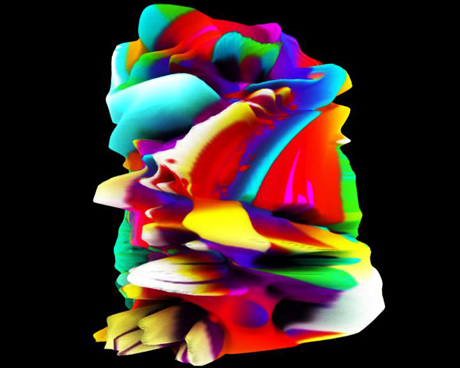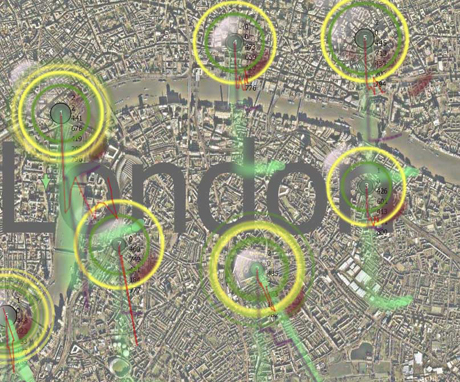



Decode: Digital Design Sensations
The Victoria and Albert museum, London
8 December 2009 – 11 April 2010
Decode: Digital Design Sensations at the Victoria and Albert Museum (V&A) brings the state of the art in art computing to a venerable cultural institution. Everything from the posters and banners around town to the hoardings on the entrance to the gallery containing the show makes it clear that Decode is a serious cultural event. It’s a spectacle, a dark space alongside the well-lit galleries of the V&A, drawing you in with points of light and distant sounds. The crowds are reassuring for the popularity of art computing yet disconcerting for the experience of the art at times.
Don’t forget to ask for a catalogue as you hand over your ticket on the way in. The sponsor’s foreword should raise a smile to anyone familiar with the software industry, but the introductory essay (which only occasionally becomes the latest casualty of the confusion that the word “open” shows), the details of works in the show and the interviews with Golan Levin and Daniel Rozin are all very informative. The catalogue also draws attention to Karsten Schmidt’s specially commissioned graphic identity for the show, which can be downloaded and modified as Free Software.
The show is divided into three sections. Generative art, data visualisation, and interactive multimedia (or, as the catalogue puts it – Code, Network and Interactivity).

The generative artworks suffer in comparison to the other pieces by being mostly small-scale screen based pieces. However appealing the images are on the screen (and they are) they cannot compete with the projections and three dimensional installations of the other sections. With the exception of an interactive version of the video to Radiohead’s House of Cards by James Frost and Aaron Koblin, the work does not refer to the human figure or to the viewer, another feature of many of the most popular pieces in the other sections. And apart from Matt Pyke’s typographic totem pole, my other favourite piece of the section, the work is calm. Beautiful, but calm. It would reward prolonged contemplation in a quieter environment and might benefit from presentation on a larger scale to better bring out its aesthetic qualities. But this is not that environment, and that presentation is not given to the work here.

The data visualisation section has more projections and custom hardware, and also has more human interest. The emotion of We Feel Fine by Jonathan Harris and Sep Kamvar, the surveillance state expose of Stanza’s Sensity, CCTV assemblages, Make-Out, the porn-inspired kissing figures of Rafael Lozano-Hemmer and the social data visualizations of Social Collider by Sascha Pohflepp & Karsten Schmidt are sometimes less visually sophisticated than some of the generative pieces, but address current social and technological developments more directly. The world wide web is twenty years old, it has drawn in the mass media and media feeds from the real world, and many of its users produce and encounter gigabytes of data over time. Representing and exploring that technological and cultural environment is something that art can do and that art is particulalry well placed to do given the importance of the aesthetics of interfacing and visualisation to the contemporary web.

The interactive multimedia section contained the real crowd pleasers of the show, although some of the pieces had “out of order” notices on them when I visited. Yoke’s virtual reality Dandelion Clock controlled by a hairdryer, Ross Phillips’s Videogrid, a physically interactive group portrait and Daniel Rozin’s Weave Mirror, a cybernetic sculpture-cum-display-screen. They all give their audience an aesthetic experience that briefly changes their relationship to the world, and in some cases shows them themselves in that new relationship. Interactive multimedia installation is clearly due a resurgence.
The V&A have presented Decode as a design show. I was struck by this framing of the work when I visited the show, and most of the people I have spoken to about the show since have commented on it as well. Many of the participants are graphic designers or work in design as well as art and education, but much of the work would be poorly served by being regarded as design rather than as art. It is not advertising, or presentation of anything other than itself for the most part. Where the work is information design, the information has been chosen by the designer. That said the art computing MA I attended as a student had to be called a “design” course to get funding, so possibly this is a constant. And the V&A have done a great job of presenting the work and letting it speak for itself to the visiting crowds.
This isn’t quite Cybernetic Serendipity 2.0. It excludes the conceptually and performatively, rougher edges of contemporary art computing. But these exclusions are largely practical; there is no livecoding and there are no email or self-contained web browser-based works. Some of the work is strikingly but subtly political in its representation of current social and political trends such as surveillance, online pornography and the death of privacy.
The V&A have done the conventional artworld and the general public a great service by presenting Decode. The show contains enough big and up-and-coming names in art computing and digital design to provide a convincing if necessarily incomplete survey of the contemporary scene. Decode also serves an important role for artists and students with an interest in or a stake in art computing by focussing attention on what others have achieved that can be built on.
Decode shows the achievements of the personal computing and web eras of art computing becoming established with and recognized by the broader arts establishment. The danger is that the story will finish triumphally here. Processing has become the new Shockwave, and particle systems and shape grammars are not enough in themselves for long without an accompanying progressive and deeper deeper engagement with the aesthetics and history of art, technology, wider society, or all three. Art computing is not immune to technical and aethetic conservatism. To avoid this I think that it needs to intensify, to become more like itself; to become more beautiful, to tackle larger datasets, to become more interactive. In other words, it needs to build on the achievements gathered together and presented here.
http://www.vam.ac.uk/exhibitions/future_exhibs/Decode/
The text of this review is licenced under the Creative Commons BY-SA 3.0 Licence.